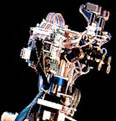
 Generation of Extinction
Generation of Extinction
Phagamys orthodon
Mus musculus muralis
Hypnomys morpheus
Hypnomys mahonensis
Thyrrhenicola hanceni
Pitymys bavaricus
Mammothus primigenius
Equus hemionus anatoliensis
Equus ferus silverstris
Prolagus sardus
Prolagus corcianus
Nesiotites similis
Nesiotites corsicanus
Panthera tigris virgaes
Panthera pardus tulliana
Panthera leo europaea
Felis lynx sardiniae
Sinotherium sardus
Canis lupus minor
Canis lupus deiesnus
Hippopoesmus sp.nov
Mecodema punctellum
Candibrervus ropalophorus
Candibrervus rethymnensis
Myotragus balearicus
Capra pyrenaica pyrenaica
Capra pyrenaica lusiesnica
Anthicus antiochensis
Aplothorax bunrchelli
Atelothrus transiens
Blackburnia insignis
Chaetotrechiana kiuchii
Disenochus micantipennis
Ishikawatrechus intermedius
Rangifer esrandus


The Generation of Extinction
NOVUS.EXTINCTUS borrows from the seductive vocabulary of advertising. On entering the site, a series of enigmatic interfaces distracts attention from the severe, central theme. Although it is not immediately apparent, the NOVUS.EXTINCTUS site is structured linearly, not unlike the so-called ‘wizards’ meant to guide people through software installations. The browser's ‘back’ button is disabled. With few options apparent, the effect is to compel the viewer onward. Many contemporary societies appear to relate to the environment in a similar, constrained way. In a state of distraction. This uncertain movement, blindly forward, is equally the subject of NOVUS.EXTINCTUS.

NOVUS.EXTINCTUS tries to reconsider turn-of-the-century e-culture from the point of view of the endangered species. Since all the paths of its interactive narrative lead to a fruitless hybridization of genetic and computer-language codes, one is led to consider whether codes offer solutions. Whether instant online databases of genetic data or fancy Web sites have anything to offer species at the verge of extinction.
[ Next ]
 Introduction
Introduction